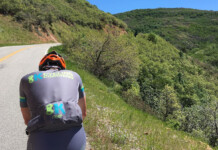By Cari Junge
My gift to you this Holiday Season is a ‘simple’ formula designed specifically to create your own 12-month training plan for 2013! Why do you need a Training Plan?
Today’s triathlete tends to be driven by the thrill-of or gains-from competition, and the first rule for performing at your best is planning. Since many of us fall into the ‘number junkie’ category, I’ve chosen a quantifiable approach as a means of drawing you in. To those like me that look at the symbols as a blur, hang in there. . .
These days there are races to choose from nearly every weekend of the 12-month cycle- whether a cyclist, runner or triathlete looking for an A (priority), B (training) or C (chill) race. It’s up to you to decide ‘what- to’, ‘when-to’, and ‘how-to’ as an age grouper. Most are drawn to triathlon as a want which often turns into a need, where things can get dangerous; I’m talking triathlon not marriage. Just like marriage, if you can figure out the right variables to complete this equation, success is that easy!
Let’s break down the Equation using a Case Study to better understand the process of applying this formula to plan development. The following measuring system is used to fill in the variables:
1 (lowest quality or load) – 5 (highest quality or load)
STEP 1: ‘A- GOALS’ For Sport and Life
Illustrated in formula as: [training plan Competition (PR + HR)
Is your priority race of choice the best one for you?
There are many factors to consider in answering this question. For now, let’s focus on timing relative to your life situation. Perhaps a better way to phrase the question is, ‘Can you stop Life to hyper-focus on this Competition?’
The answer, especially for long-course, likely needs to be closer to ‘yes’ than ‘no’. It’s your pre-developed Training Plan that will factor the impact life will have on race day and the training period leading up to it. Let’s look at variables referenced in the training plan formula and define their roles:
Training Plan for Competition: (tpC) where C stands for Competition: defined as the result of time spent, investments made, and loads applied. It takes discipline to reach rewarding results with fun factor, though disappointments in the moment can outweigh gains made along the journey. Success most often depends on your Plan, being on-going and personalized, event-specific, with time to prepare and an overlay of life’s races integrated.
Priority Race: (PR): defined as the most important triathlon(s) on your calendar. Unless you’re elite, the mind.body can rarely manage more than 2-3 A-races per 12-month cycle without breakdown. It’s most often within your control to select the competition. Do so with foresight relative to that which may arise beyond your control in life while training and racing. Chances are last minute, the race will have to go, not Life.
Human Race (HR): defined as everyday Life, which for many of us can cause insurmountable stress. It takes great strength to step away from triathlons during loaded life-training in order to succeed at your Human Race. There’s always time to add the PR once the HR is under control though not always vice-versa. It can be beyond your control to change. . .
Therefore, the equation to develop a triathlon training plan results in a well thought out roadmap preparing you for a multi-sport race while integrating a healthy and realistic overlay of real-life competition.
STEP 2: SCHEDULE For Sport and Life
Illustrated in formula as: [Cycle (#Blocks)/#Seasons]
Whether training for “A- Triathlon” or “A- Busy Period” in Life, they both are Competitions, needing a plan for progression. To prepare effectively, break down your timeline into calculated periods and patterns using the following vocabulary referenced in the formula:
Cycle (Cy): defined as a complete sequence or circular pattern involving a series of steps that lead you back to the starting point. The 12-month Cycle in endurance sports training is a healthy timeline to plan holistically. For some, we expand into studying a macro-cycle of 4-years where the 1-year period is a micro-cycle.
Season (Se): defined as a period of time traditionally designated by the evolution of nature and weather patterns that breaks up the 12-month Cycle. For some endurance athletes, this term defines timeline to focus on one sport at a time such as winter skiing, spring running, etc. Or this months-long period may separate training focus from competition or race mode. A Cycle traditionally breaks down to 4 seasons though a 3-season year is viable as well.
Block (Bl): defined as a period of time with focused progression designed by calculated training loads followed by recovery in order to maximize gains without breakdown. These Blocks build progressively upon each other within a Season and may be represented by days or weeks.
Having a clear vision of a typical week within a blocking pattern to build your season becomes the framework from which to establish workouts that are safe, specific and motivating.
STEP 3: PERSONAL ANCHORS For Sport and Life
Illustrated in formula as: (PhRe +PsWe +DiNu +Ls +SuNe)
You now have a sense of competition goals and timeline. How do you customize a training plan to your unique qualities? . . . The quick answer is: with analysis, input, foresight, and sometimes harsh reality. The lengthy process ideally includes an evaluation of your 5 mind.body anchors, performed by you or a professional. It’s important to focus on today’s you, and to be open to revisiting Steps 1 & 2 based on your findings.
Rate the following 5 anchors on a scale of 1 (low) to 5 (high) in order to prioritize time and energy where most valuable and necessary across your training plan:
1- Physical Readiness (PhRe): state of health relative to anatomical structure, physiological systems, general and sport-specific fitness, biomechanics and historical impact.
2- Psychological Wellbeing (PsWe): state of emotional health, brain chemistry noted from mood and motivation levels, mental training capacity, and historical impact.
3- Diet | Nutrition (DiNu): current and past experience with intake patterns for healthy lifestyle and sports performance. Education, re-patterning and methodology are considered.
4-Daily Lifestyle (Ls): current state of lifestyle patterns relative to schedule and consistency with sleep, meals, work, home, play, rest and more.
5- Support Network (SuNe): people, places and things that provide grounding, guidance, support and understanding such as family, friend, colleague, coach, and more.
STEP 4: WORK to REST BALANCE For Sport and Life
Illustrated in formula as: [PR (Work-y+Rest-y) + HR(Work-z+Rest-z)]
We are busy at work 24/7-365 as a population. Each of us comes into the world with specific needs for rest and recovery to balance the loads we apply, and environmental impact shifts those ratios based on where we live, what we do for a living, what time of year, etc…
When establishing your personal rules for balancing the work or load applied/ needed to grow each anchor with the recovery/ rest time to allow those loads to settle and instill progression, understand that these variables could be ever-changing based on feedback. Turn the definitions provided for each anchor into a question in order to assess if you are making gains, sitting stagnant or experiencing set-backs in your training. Your findings may require a change in Plan.
To apply numbers to this segment of the formula, use your 1-5 scale to apply variables representing time and energy involved to instill healthy patterns for each anchor relative to work load and recovery needs. For example you may have a very steady healthy diet which you find to fuel your efforts well so the work involved is low meaning little change and recovery to it may be equal or higher meaning to gain back time in this anchor of life to channel elsewhere.
STEP 5: TRAINING PLAN For Sport and Life
Create your Plan! Using the formula is optional!
You now have the key information to be mindful of when creating your Competition Training Plan. How basic or detailed, what tools and technology, and what resources you enroll are your choice.
For some the hardest part is resolving the Plan itself. Those of you that have enjoyed the idea of applying a formula to this process, see the sidebar illustration to complete your equation. Others might jump right into a spreadsheet, graphic drawing or other means to lay out your 12-month cycle with the following key indicators:
• 12-Month Cycle Grid: Create a visual representation showing the 12-month cycle broken up into months and weeks with dates included to see the big picture. You can graphically represent your ‘seasons’ as well. Be sure to use a system that is easily changeable as things will change!
• Competition Date(s): you might color code Priority Race differently from Human Race events or start with PR only and overlay HR as it makes sense.
• Countdown: Count back weeks from race dates to when your Plan begins. The goal is to understand how much time you have for your training plan overall and then use each week counting back as markers for micro-goals. For example, being 20-weeks out from a Half-Iron, you might decide you want to reach technique goals in the pool by 14 weeks-out which was noted in your Physical Readiness Anchor.
• Season/ Blocks: Visually represent in color or line weight how you will illustrate training blocks to see the big picture timeline broken into micro-periods for progress checkpoints, B and C race integration, Human Race impact, etc.. For example you might choose to use 3-week blocks built by 2-weeks building load and the 3rd week recovery. Color-code the different types of loads so you can time life stuff accordingly or vice versa.
• Creative Anchor Overlays: develop your own system to represent the areas you want/ need to focus across the cycle. This may be done a block or season at a time to keep your grid clean. You might choose to include indicators for nutrition goals, work deadlines, cross-training classes, etc… This layer of detail may represent your personality graphically- it may include race course photos, mantras you live by, your favorite workouts, etc…
Your optimal training plan may take years to develop. Along the way, you might find the plan as good as it is easy to break. When in doubt, re-visit the 5-Steps, re-open your mind to see change as opportunity, and respect the ever-evolving nature of Life. Your performance gains will follow!
Cari Junge is Director of Nutrition and Therapy at Utah Sport and Wellness and shares over 20 years of experience as an Industry Leader in Health, Fitness & Wellness with expertise as an Endurance Coach and athlete. Accolades include but not limited to: USATriathlon & USACycling Level II Coach, Former Carmichael Training Systems® Expert Coach, 8x Ironman Triathlete. To reach her, visit www.utahsportsandwellness.com







